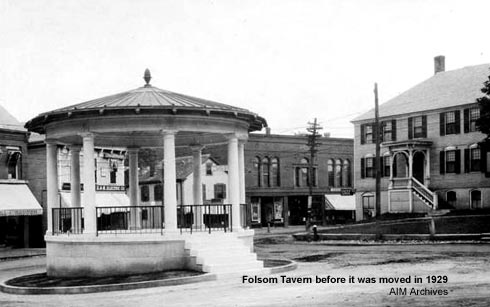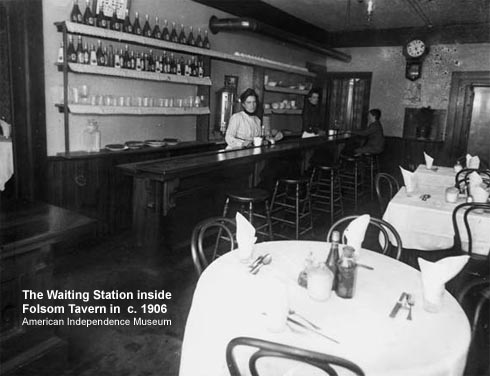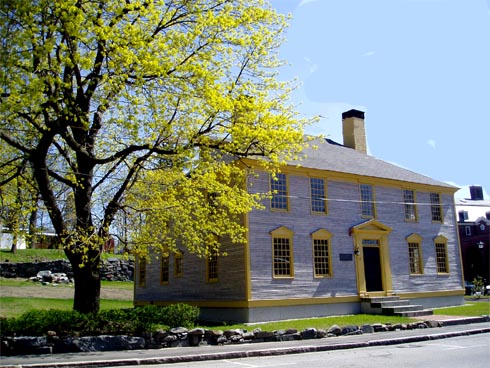|
FRESH STUFF DAILY |
|
|
||
|
|
||
|
|
||
|
SEE ALL SIGNED BOOKS by J. Dennis Robinson click here |
||
Page 2 of 2
The Folsom Tavern, once located across from the famous bandstand in Exeter center, was moved previously. Back in 1929 early Exeter preservationists purchased the building for a dollar and transported it a quarter of a mile down Water Street. Originally named "The Raleigh", the tavern had already survived many uses by then. The first owner Samuel Folsom and his brother Nathaniel fought in the American Revolution back when Exeter was a hotbed of colonial politics. The New Hampshire Society of the Cincinnati, a private hereditary club for Revolutionary War leaders and named after a Roman general, was founded at the tavern in 1783. Six years later President George Washington, a founding member of the Cincinnati Society, stopped by the Folsom Tavern for breakfast while touring the newly formed nation. His short visit helped inoculate the tavern against destruction.
During the heady era following the Revolution, while the founders hammered out the Constitution, Exeter was the temporary capital of New Hampshire. Folsom’s wife Elizabeth later ran the tavern as "Widow Folsom’s Inn" until 1805. After the Civil War, the building was pushed back as Water Street was widened, then raised up so that a brick store could be added below. It became an antiques "curiosity" shop and was later owned by a local "mystic", then transformed into "Washington's Lunch" and a waiting station for the nearby trains and trolley cars. The building served as office space, a Chinese laundry, a milliner's store and a shoe repair shop. When new owners decided to raze the Folsom Tavern to build a gas station in 1929, the Society of the Cincinnati stepped in to save its New Hampshire birthplace. These descendents of Revolutionary War leaders moved the building. It sat vacant for nearly two decades until preservationist Mrs. Martha Foster Stearns offered to restore the ancient home in 1947 in exchange for the right to live there. The Society agreed. "She really did a very careful job," Burdick says of Stearns. "Under the guidance of Boston architects, she duplicated early wallpapers, matched crown moldings, and accurately reproduced missing pilasters. We've set aside one room in the tavern in Mrs. Stearns’ honor." In the early 1950s the building was rented to Phillips Exeter Academy for faculty housing until the creation of the American Independence Museum in 1991. Despite its many uses, John Merkle says, the tavern still retains some of its original 18th century features including the classic front hall and stairway with its hand-turned balustrades. Although plaster walls and ceilings are again being replaced, there are beautiful examples of raised wooden paneling, classical cornices and double-faced doors that Washington himself may have seen. Even the new location on Water Street proved to be an historic well spring. A team led by archeologist Ellen Marlatt discovered over 1,000 artifacts last fall while testing the ground beneath the new Folsom Tavern site. Many of the items, mostly ceramics, came from the same Revolutionary period when the tavern was built.
The quality and quantity of this rare archeological evidence, Marlatt says, proves that Exeter in the 1700s was an active seaport much like Portsmouth. Over time, research shows, the new museum site has also seen residential use, merchant shops, a church and an opera house -- all now gone. Leaving no stone unturned, Burdick also brought on a professional landscape architect to redesign the one-acre downtown site. Robert Hoover says his job was to envision the many outdoor "rooms" in the evolving museum campus. "Think of the landscape as a pallet, "says Hoover of HBLA, Inc. "Parking lots, walks, plantings, lighting, drainage, grading -- everything you see has to come together as a theme. Here, we want to get the building back to the people." Hoover commends the work done by Exeter town officials, by Phillips Exeter Academy (founded in 1781), by AIM board members, the civil engineer, by so many volunteers, artisans, researchers, professionals and craftspeople who have gotten this project off the ground. "This is much more than moving a building," architect Merkle says. "Much, much more." "And yet," Burdick adds, "if George Washington were to return to Exeter, I like to think, he'd find the familiar Folsom Tavern as welcoming as ever."
Please visit these SeacoastNH.com ad partners.
News about Portsmouth from Fosters.com |
| Thursday, April 18, 2024 |


|
Copyright ® 1996-2020 SeacoastNH.com. All rights reserved. Privacy Statement
Site maintained by ad-cetera graphics

 Smuttynose Murders
Smuttynose Murders





















